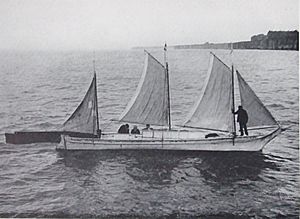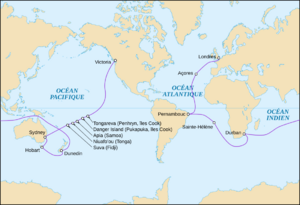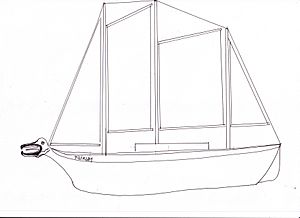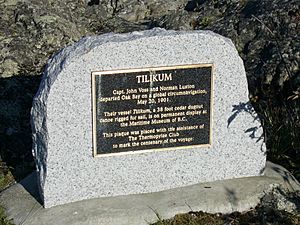Tilikum (boat) facts for kids

Tilikum at Margate with Captain John Voss standing at the bows
|
|
Quick facts for kids History |
|
|---|---|
| Name | Tilikum |
| Owner | Unknown Nootka woman |
| Cost | $80, in silver, in April 1901 |
| Laid down | Early 1800s |
| Acquired | John Voss, 1901 |
| Status | Museum ship |
| General characteristics | |
| Class and type | Dugout canoe, of red cedar, rigged as a sailing canoe in 1901 |
| Length | 38 ft. (12 m) |
| Sail plan | Gaff-rigged schooner, 230 square ft. (21 m2) sail area, added for 1901 voyage |
The Tilikum was a 38-foot (12 m) dugout canoe that made an amazing journey around the world starting in 1901. This special boat was a traditional canoe built by the Nuu-chah-nulth people, an Indigenous group from the Pacific Northwest. It was already quite old when Captain John Voss bought it in April 1901.
The Tilikum was carved from a huge red cedar log in the early 1800s. Captain Voss bought it for $80 in silver from a local woman. The name Tilikum means "friend" in Chinook jargon, a trade language once used in the Pacific Northwest. Voss and his friend, Norman Luxton, were inspired by Joshua Slocum. Slocum had sailed his 37-foot (11 m) boat, the Spray, around the world a few years earlier and wrote a popular book about it.
Contents
Preparing for the Great Voyage
Before its big trip, the Tilikum needed a lot of work. It was strengthened and covered. New sails were added, totaling 230 square feet (21 m2) of sail area. All this work was done at a shipyard in Spotlight Cove on Galiano Island.
After the refit, the Tilikum sailed to Oak Bay harbour. From there, Captain Voss and his mate, Norman Luxton, officially started their journey on May 20, 1901. Their first destination was the Cook Islands.
Challenges on the Pacific Ocean
The journey was full of challenges. After sailing 10,000 miles (16,000 km) across the Pacific Ocean for five months, the Tilikum hit a coral reef. Norman Luxton was thrown from the boat and badly cut by the sharp coral.
The damaged boat managed to reach Penrhyn Island in the Cook Islands on September 2, 1901. Luxton decided to leave the trip in Suva, Fiji on October 17, 1901. Over the next few years, ten more men joined and left the crew before the Tilikum finally arrived in London, England, in September 1904.
Losing the Way
After leaving Suva on October 25, 1901, another mate, Louis Begent, was lost at sea along with the boat's compass. Captain Voss was now alone and had no compass. He was still 1,200 miles (1,900 km) away from Sydney, Australia!
Exhibitions and Repairs
The Tilikum reached Melbourne, Australia, on March 13, 1902. It was put on display with all its sails up in Collins Street. Later, it was moved to the Exhibition Buildings. During this move, a hook broke while loading the boat onto a wagon. The Tilikum was damaged, with cracks appearing in five different places. Captain Voss repaired it himself using thin steel ribs.
After repairs, the Tilikum sailed on Lake Wendouree in Ballarat. Local sailors gave the boat a new set of sails. Then, it traveled to Geelong to return to the sea.
Remembering the Journey
Captain John Voss gave talks in Britain about his incredible voyage. He was even nominated to become a Fellow of the Royal Geographical Society in London, a group that supports geographical exploration.
Years later, Captain Voss wrote a book about his adventures called The Venturesome Voyages of Captain Voss, published in 1913. Norman Luxton, his first mate, also wrote his own story of the trip in his Tilikum Journal. This was published after his death in 1971 as Tilikum: Luxton's Pacific Crossing.
Tilikum's Final Home
After its journey, the Tilikum was in London for a while. It changed owners several times and lost its bowsprit (the pole sticking out from the front) and masts. In 1929, the Furness Shipping Line brought the Tilikum back to Victoria, British Columbia.
The boat began to be restored in 1936 by the Thermopylae Club. In 1965, it was moved to the Maritime Museum of British Columbia, where it stayed until 2015. After that, the Tilikum was displayed at the Ogden Point cruise ship terminal in Victoria, B.C. Currently, the Maritime Museum of British Columbia does not have the Tilikum on display.
Images for kids








